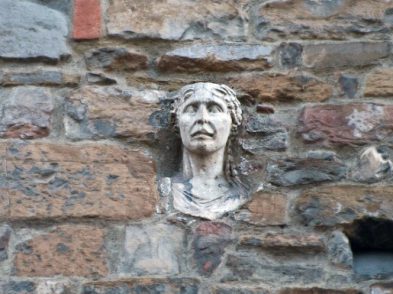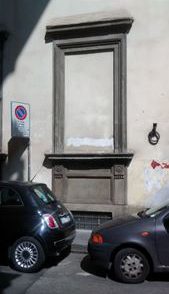The Medici family has always been associated with balls. Six of them to be exact. Their family emblem, five red balls (palle, in Italian) and one blue, on a gold shield, decorate numerous buildings all over Florence and Tuscany-any palazzo, church or monument to which the Medici had connections or that was financed using Medici money. Considering that at their prime the family had its fingers in virtually every pie in Florence, it is not surprising that half the buildings in the city seem to display the symbol. A coontemporary of Cosimo il Vecchio once declared, outraged, that in the church of San Marco, ‘he had even emblazoned the monks’ privies with his balls!’
Even though this symbol of Medici power is widely recognised, its origins are shrouded in mystery and have been the object of much speculation through the centuries. The most captivating, but almost certainly apocryphal, theory is that the balls represent dents in a shield, inflicted on one of Charlemagne’s knights, Averardo, by the fearsome giant Mugello. In their time, the Medici claimed to be descended from this heroic, but most likely fictional, cavalier. The story goes that Averardo eventually defeated the giant, and as a reward for ridding the land of such a terrible monster, Charlemagne not only gave him the dead giant’s lands (the area of the Mugello, home to the Medici) but also granted him permission to use the image of his mauled shield as a coat of arms.

Other, more credible theories posit less distinguished origins for the balls. Some say they represent pharmaceutical pills, or possibly cupping glasses (a late-medieval medical instrument used to draw blood), recalling the possible origins of the Medici as doctors (the Italian word for ‘doctors’ is medici). However, many people claim that this story was in fact invented at the French court in the sixteenth century in order to slander Queen Caterina de’ Medici by reminding the people of her humble origins. The balls are also sometimes said to be bitter red oranges, alluding to the trade the Medici family conducted with the East. Others believe the balls are bezants, Byzantine coins, copied from the coat of arms of the Guild of Moneychangers (Arte del Cambio) to which the Medici belonged. Family members occasionally used different numbers of balls; evidence of this can be still be seen around Florence: San Lorenzo’s Old Sacristy contains both a shield with seven balls, while another on the ceiling has eight, and Cosimo I’s tomb in the Cappelle Medicee displays only five.
Whatever their origin, the balls became inextricably tied to the Medici family and all they did. Their rallying cry in times of war was Palle, palle, palle! In 1496, there were so many Medici coats of arms on the buildings of Florence that Savonarola, the famous critic and reformist, claimed that even the places of importance usually reserved for the crucifix in churches had been usurped by the Medici’s balls.







